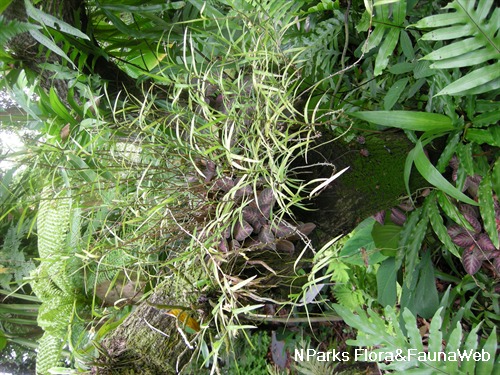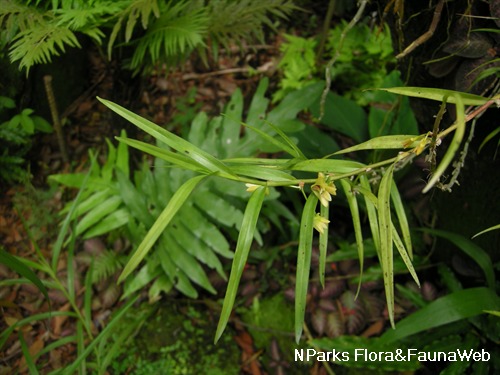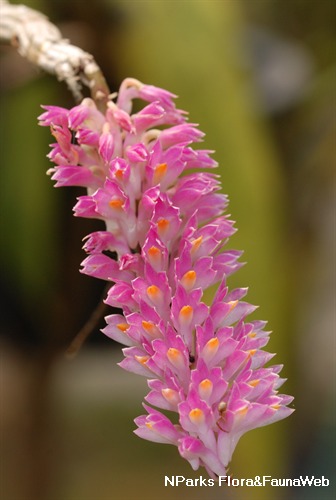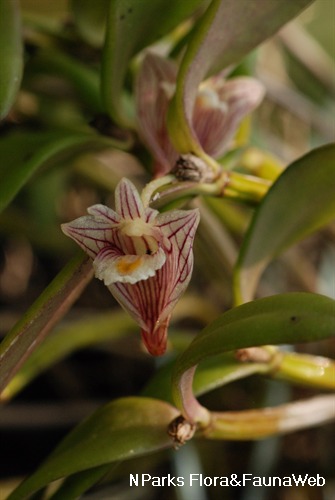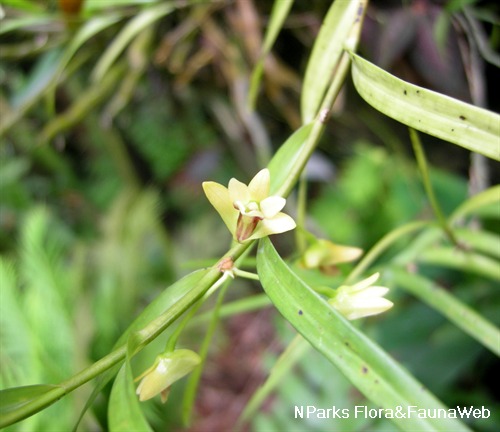
Name
Classifications and Characteristics
| Plant Division | Angiosperms (Flowering Seed Plants) (Monocotyledon) |
|---|---|
| Plant Growth Form | Epiphyte |
| Lifespan (in Singapore) | Perennial |
| Mode of Nutrition | Autotrophic |
Biogeography
| Native Distribution | China, Tibet, Sri Lanka, Myanmar, Thailand, Vietnam, Borneo, Indonesia, Singapore and Peninsular Malaysia. |
|---|---|
| Native Habitat | Terrestrial |
| Local Conservation Status | Native to Singapore (Presumed Nationally Extinct (NEx)) |
Description and Ethnobotany
| Growth Form | A sympodial, epiphytic orchid about 70cm tall. |
|---|---|
| Foliage | The leaves are narrowly lanceolate. |
| Stems | The stems are thin and pendulous and are bamboo-like and cylindrical in shape. The lower parts of the stems are covered with leaf sheaths. |
| Flowers | The flower inflorescence emerges through the sheaths and are leaf-opposed. Each inflorescence bears 1 to 4 flowers. The floral bracts are brown and shell-like. The flower has yellow petals and sepals. The flower lip is purple and yellow on the inner and outer surface. The column and anther cap are yellow. |
| Cultivation | It is best grown under partial sun with moderate water and in a free-draining growing medium. |
Landscaping Features
| Desirable Plant Features | Ornamental Foliage, Ornamental Stems |
|---|---|
| Landscape Uses | Parks & Gardens, Small Gardens |
| Thematic Landscaping | Naturalistic Garden |
Plant Care and Propagation
| Light Preference | Semi-Shade |
|---|---|
| Water Preference | Moderate Water |
| Propagation Method | Seed, Division |
Foliar
| Foliar Arrangement Along Stem | Alternate |
|---|
Floral (Angiosperm)
| Flower & Plant Sexuality | Bisexual Flowers |
| Flower Colour(s) | Yellow / Golden |
|---|---|
| Flower Texture(s) | Smooth |
| Flower Grouping | Cluster / Inflorescence |
| Flower Location | Axillary |
Image Repository
Others
| Master ID | 31590 |
|---|---|
| Species ID | 5989 |
| Flora Disclaimer | The information in this website has been compiled from reliable sources, such as reference works on medicinal plants. It is not a substitute for medical advice or treatment and NParks does not purport to provide any medical advice. Readers should always consult his/her physician before using or consuming a plant for medicinal purposes. |

